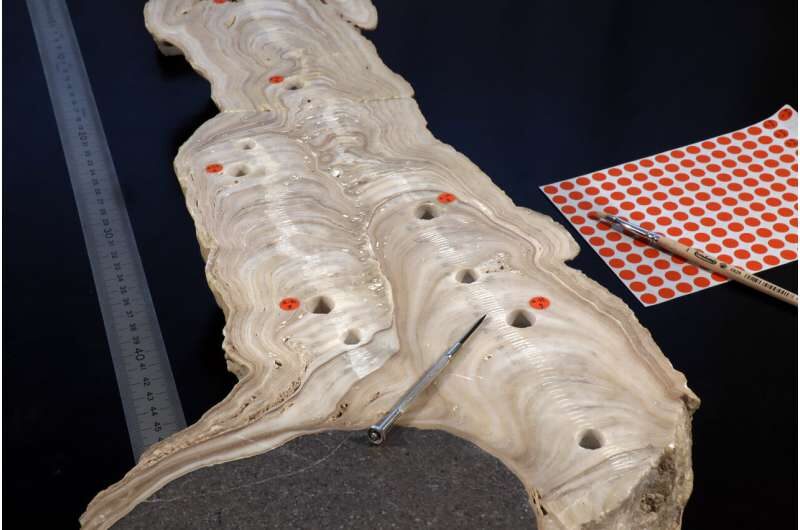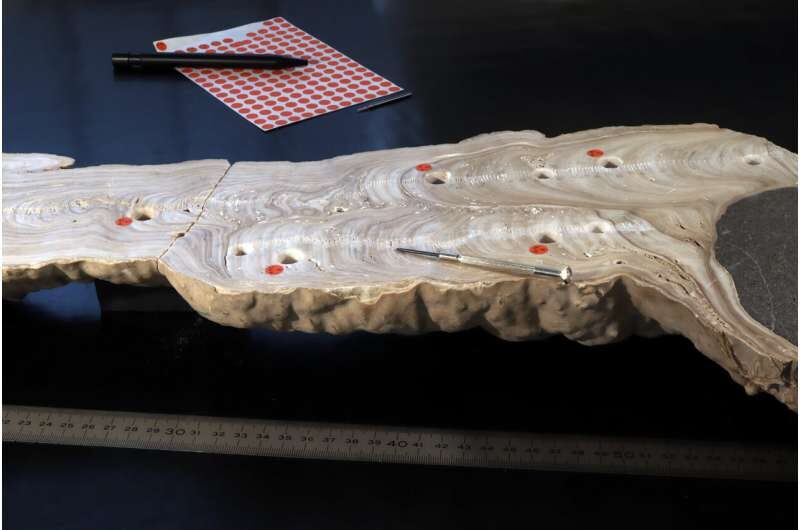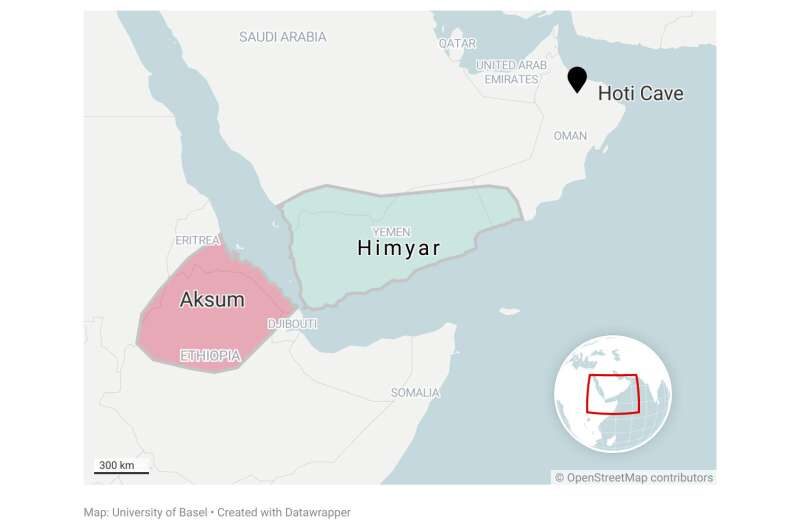
På højsletterne i Yemen kan man stadig finde spor af det himyaritiske kongerige i dag: terrassemarker og dæmninger udgjorde en del af et særligt sofistikeret kunstvandingssystem, der forvandlede halvørkenen til frugtbare marker. Himyar var en etableret del af Sydarabien i flere århundreder.
På trods af sin tidligere styrke gik riget i løbet af det sjette århundrede e.Kr. ind i en kriseperiode, som kulminerede med dets erobring af nabokongeriget Aksum (nu Etiopien). En tidligere overset faktor, nemlig ekstrem tørke, kan have været afgørende for at bidrage til de omvæltninger i det gamle Arabien, hvorfra islam opstod i løbet af det syvende århundrede.
Petrified water acts as climate record
Fleitmann's team analyzed the layers of a stalagmite from the Al Hoota Cave in present-day Oman. The stalagmite's growth rate and the chemical composition of its layers (see box) are directly related to how much precipitation falls above the cave. As a result, the shape and isotopic composition of the deposited layers of a stalagmite represent a valuable record of historical climate.

Isotopic analysis of the stalagmites layers allows researchers to draw conclusions about annual rainfall amounts. For example, they discovered not only that less rain fell over a longer period, but that there must have been an extreme drought. Based on the radioactive decay of uranium, the researchers were able to date this dry period to the early sixth century CE, albeit only with an accuracy of 30 years.
Detective work in the case of Himyar's demise
"Whether there was a direct temporal correlation between this drought and the decline of the Himyarite Kingdom, or whether it actually didn't begin until afterwards — that was not possible to determine conclusively from this data alone," explains Fleitmann. He therefore analyzed further climate reconstructions from the region and combed through historical sources, collaborating with historians to narrow down the time of the extreme drought, which lasted several years.

"Water is absolutely the most important resource. It is clear that a decrease in rainfall and especially several years of extreme drought could destabilize a vulnerable semi-desert kingdom," says Fleitmann. Furthermore, the irrigation systems required constant maintenance and repairs, which could only be achieved with tens of thousands of well-organized workers. The population of Himyar, stricken by water scarcity, was presumably no longer able to ensure this laborious maintenance, aggravating the situation further.
Political unrest in its own territory and a war between its northern neighbors, the Byzantine and Sasanian Empires, spilling over into Himyar, further weakened the kingdom. When its western neighbor of Aksum finally invaded Himyar and conquered the realm, the formerly powerful state definitively lost significance.

"When we think of extreme weather events, we often think only of a short period afterwards, limited to a few years," Fleitmann says. The fact that changes in the climate can lead to states being destabilized, thereby changing the course of history, is often disregarded. "The population was experiencing great hardship as a result of starvation and war. This meant Islam met with fertile ground: people were searching for new hope, something that could bring people together again as a society. The new religion offered this."
Comment: One suspects that these people must have suffered significant hardships which left them particularly desperate and willing to adopt rather radical practices in the hope that this exchange of obedience would guarantee them a return to some semblance of normality.
That does not mean to say the drought directly brought about the emergence of Islam, emphasizes the researcher. "However, it was an important factor in the context of the upheavals in the Arabian world of the sixth century."
Comment: There's good reason to believe that the area experienced a number of catastrophic events: 536 AD: Plague, famine, drought, cold, and a mysterious fog that lasted 18 months
Precipitation and stalagmites
In tropical and sub-tropical regions, there is a connection (correlation) between the amount of precipitation and its isotopic composition, also known as the "amount effect." The more it rains, the more the ratio between the lighter and heavier oxygen isotopes, 16O and 18O, shifts in favor of the lighter 16O in the precipitation. These changes are recorded in the stalagmite from Oman, as it is formed from dripping rainwater. Based on isotopic measurements of the stalagmite's limestone layers, it is possible to determine the exact ratio of 16O and 18O and, in combination with uranium dating, to reconstruct how much it rained at what point in time.
More information: Dominik Fleitmann et al, Droughts and societal change: the environmental context for the emergence of Islam in late Antique Arabia, Science (2022). DOI: 10.1126/science.abg4044. www.science.org/doi/10.1126/science.abg4044
Journal information: Science
Provided by University of Basel



Kommentar: See also:
- The Arabian cradle of Zion: Moses, Muhammad, and Wahhabo-Zionism
- New Light on the Black Death: The Cosmic Connection
- Polytheism and human sacrifice in early Israelite religion
And check out SOTT radio's: